
Table of Contents
Scientific Classification
- Kingdom: Animalia
- Phylum: Chordata
- Class: Reptilia
- Order: Squamata
- Family: Iguanidae
- Genus: Iguana
- Species: I. iguana
Quick Overview
The Green Iguana (Iguana iguana), often simply referred to as “iguana,” is one of the most recognizable and widespread reptiles. Native to Central and South America and the Caribbean, these lizards have become iconic in popular culture and have also been introduced to regions outside their natural habitat, partly due to the pet trade.
Fast Facts
- Scientific Name: “Iguana iguana”
- Lifespan: 10-20 years in the wild; can live longer in captivity with appropriate care.
- Average Size: 4.9-6.6 feet, including tail.
- Diet: Predominantly herbivorous.
- Habitat: Rainforests, lowlands, and swamps.
Did you know?
Green Iguanas boast a row of spines running down their backs and tails, which not only enhances their distinctive appearance but also acts as a deterrent to predators.
Appearance
Although named “Green” Iguana, their color can range from bright green to grey or even display orange tones. They are characterized by a dewlap under their chin, spines down their back, and a lengthy, whip-like tail.
Size and Weight
Typically, adult Green Iguanas measure between 4.9 to 6.6 feet from head to tail tip. They can weigh anywhere from 8 to 20 pounds, with males generally surpassing females in size.
Temperament and Behavior
Primarily solitary creatures, Green Iguanas might exhibit territorial behavior, especially among males. Being diurnal, they’re most active during daylight, basking in the sun or foraging for
Fun Fact:
Green Iguanas possess exceptional vision, allowing them to perceive a wide spectrum of colors, including ultraviolet wavelengths, invisible to human eyes.
Habitat and Distribution
While indigenous to Central and South America and the Caribbean, they prefer habitats with a mix of sunlight and shade. Due to their adaptability and introduction by humans, they’ve established populations in several other areas, such as Florida, where they are considered an invasive species.
Care Guide
For prospective Green Iguana owners:
- Ensure a spacious environment with climbing opportunities.
- Maintain a humidity level suited for tropical species.
- UVB lighting is essential for calcium metabolism.
- Feed a diverse plant-based diet with a focus on leafy greens.
- Schedule regular health check-ups.
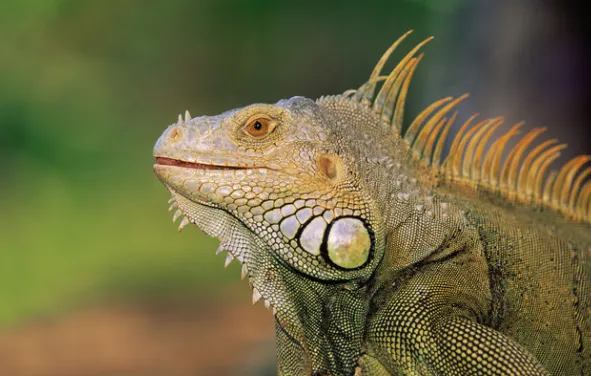
Diet and Nutrition
In nature, Green Iguanas predominantly feed on plants, favoring leaves, fruits, and flowers. When in captivity, a varied diet of greens, supplemented with vegetables and occasional fruits, is optimal.
Health and Wellness
Potential health risks include metabolic bone disease due to inadequate UVB lighting exposure. Respiratory and kidney issues might also emerge. Timely care and routine veterinary examinations can preempt most health concerns.
Breeding
Green Iguanas are oviparous. Post-mating, females lay clutches that typically contain between 20-40 eggs. After deposition, the eggs are buried in sandy or loamy substrates and incubate for about 90-120 days, depending on environmental conditions.
Conservation Status
While not currently listed as endangered, local Green Iguana populations may be affected by habitat loss and hunting. It’s crucial to monitor their status as factors like habitat destruction can influence their numbers.
Fun Fact:
In a defensive move, a Green Iguana can shed its tail to evade predators. In due course, they can regenerate a new tail, though the new one might differ in appearance from the original.
Photo Gallery
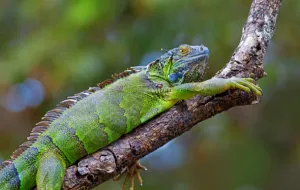
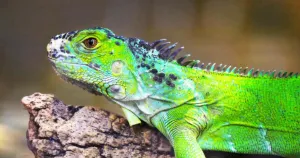
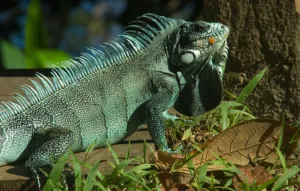
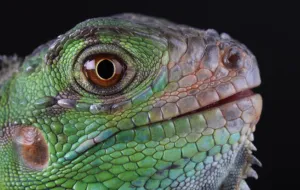
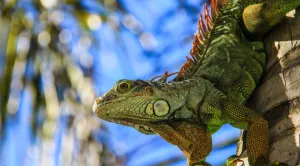
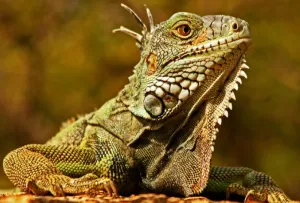
Check out the video below of green iguana gracefully swimming in the pool:
Related Profiles
Share This Profile:
3 Amazing Facts About Green Iguana
- Solar Power: Green Iguanas relish their sunbathing sessions. Sunlight aids not just in temperature regulation but also in digestion and vitamin D synthesis.
- Aquatic Skills: Residing near water bodies, Green Iguanas are adept swimmers. In water, their tail functions similarly to a crocodile’s, aiding in propulsion.
- Extended Breath-Hold: Green Iguanas can stay submerged for up to 30 minutes, reducing their metabolic rate and conserving oxygen.
- Enchi Ball Python: A Unique and Stunning Morph of Python regius - March 27, 2025
- Emerald Tree Monitor: The Enigmatic Green Guardian of the Rainforest - March 26, 2025
- The Egyptian Cobra (Naja haje): A Fascinating Serpent - March 25, 2025
